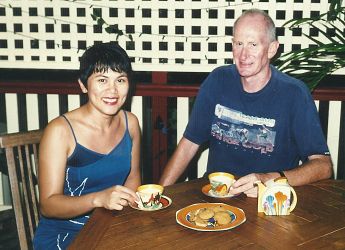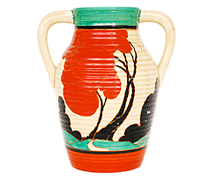Clarice Cliff Feature Articles
CLARICE CLIFF - LOVE AT FIRST SIGHT, WELL ALMOST
I believe I would be correct in stating my affair with Clarice Cliff began somewhat reluctantly but over the years has developed into a firm and committed relationship. It all started in the early nineteen eighties when I was living in Sydney, having moved from New Zealand a few years earlier to work as a flying instructor. I had little or no interest in antiques. However I was passionate about post-war MG sports cars with several having passed through my hands and I had also owned a vintage Tiger Moth bi-plane back in New Zealand - that was about the extent of my interest in ‘things old’.
Many years earlier I had met “Kip” Netherclift a fellow aviator and, after my move across “the ditch” to Australia, we had remained in contact. Kip visited me in Sydney in mid 1994 and, one day, after we had “done the rounds” of local airfields he indicated he was interested in looking over Sydney’s antique shops. The catch was he needed a guide with knowledge of the area who could navigate Sydney’s sprawl to locate the sparsely located suburban antique dealers - and that job fell to me. So it was with much
reluctance on my part that we set off one morning armed with a list of dealers on what I envisaged was going to be a rather boring (for me anyway) day.
Kip, a CCCC member at the time, had been collecting Clarice for several years and built-up a collection from visiting garage sales and auctions.
Our first “port of call” was the Sydney Antique Centre, a huge old converted warehouse which housed numerous specialist antique dealers under the one roof. We traipsed around for some time, Kip fossicking amongst what I considered junk, until he came across what he informed me was a plate by Clarice Cliff. To me the colours appeared rather insipid, and from Kip’s earlier descriptions of her work, not at all like I imagined it would be. It was quite a letdown and reinforced my belief that this was going to be a monotonous day and one which I should have avoided. I later learned the pattern on the plate was Spring Crocus and not one of Clarice’s more flamboyant designs.
The next couple of antique shops we visited produced nothing in the way of Clarice Cliff so it was on to The Old Ark Antique Centre on Broadway near Sydney city. This was another of those collective affairs which housed several specialist dealers under the one roof and was at the time home of Gallery Bizarre owned by Ian Mackay, who, unbeknown to either of us, was Sydney’s largest Clarice stockist at that time.
What greeted my eyes in Gallery Bizarre’s display cabinets was an array of objects in shapes, patterns and colour combination I’d never before seen. Kip seemed pretty much taken aback too as he “oohed” and “aahed” at the display. After seeking permission from the Centre manager Kip began videoing the items as I read out descriptions and prices from attached labels. Looking at this video today I can detect a degree of excitement rising in my voice as I read out the details.
The remainder of that day took on a new meaning for me as we proceeded from shop to shop. It became my mission to identify Clarice’s work from others as soon as we entered them and, as we drove home later, I was already planning to purchase a cabinet in which to display my future Clarice collection. I had fallen in love with Clarice Cliff!
Within a week or two I had purchased a modest display cabinet the interior of which I painted black for optimum effect and a short time later bought my first piece of Clarice Cliff pottery - a shape 331 candlestick in the Crocus pattern, purchased from an antique dealer in a nearby suburb.
At this time my knowledge as to the extent of Clarice’s work was non-existent. I had no idea how many patterns or shapes had been produced. For all I knew the next piece of her work I came across may possibly be the last I would ever see and as a consequence I tended to purchase indiscriminately. Someone told me plates were the best items to collect as the patterns displayed well on flat surfaces. Quite quickly I acquired forty or more plates, none of them very rare or exotic, and another cabinet was purchased to display them in.
However as my appreciation of Clarice’s work developed my tastes began change and I no longer found plates as appealing as they had once been. A decision was made to
sell-off the collection and fortunately with prices still rising, almost without exception I recovered a handsome profit on each piece sold. This helped finance my second collecting phase which concentrated more the diversity of shapes which I had come to find just as fascinating as her vibrant patterns which, when they first emerged more than eight decades ago, must have appeared, well, quite bizarre.
Today I have retained just half-a-dozen dinner/cake plates and these sometimes feature in my ever changing displays which I shall expand upon in a future article.
MURRAY KIRKUS
Edited by Doreen Mann
JANUARY 2014
Note: Pictured below, left to right: 1. Applique Avignon 2. A 2-tier cake plate in Blue Japan 3. Red Roofs 4. Blue Daisy 5. Black Luxor 6. Sunray 7. Murray and his lovely wife Lera relaxing on their verandah with some items from his Clarice Cliff collection. The cake plate, by the way, is in the Double V pattern, the rest you can see.






